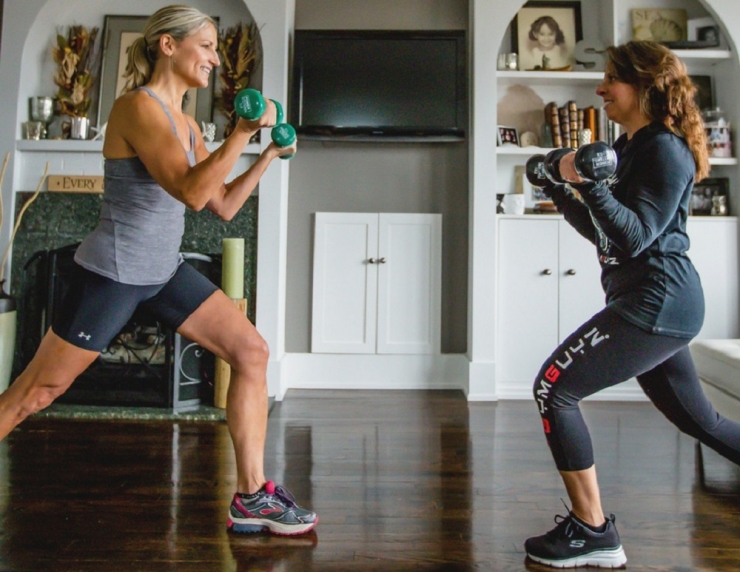
A personal trainer and a health coach are two different things. While both can be very useful in the gyms, health coaches aren't licensed as doctors and cannot recommend specific diets. Personal trainers, on the other hand, can only provide training and a weekly workout routine. Health coaches, on other hand, care more about long-term results for their clients. The main differences between the two are in their scope of practice and certifications.
Individualized program
Although personal trainers are different from health coaches in how they approach clients, there are many similarities between the two professions. Both are experts in helping clients reach their fitness goals. Personal trainers were traditionally focused on helping clients reach their physical goals. Health coaches are more diverse. In addition, both professions are not limited to a specific type of environment.
A personal trainer is focused on the techniques and goals of getting physical fitness. A health coach helps clients make dietary and behavioral changes as well as assist with injury rehabilitation. A health coach uses their expertise in health and wellness to help clients design a custom plan that includes all aspects. A health coach can help clients reach long-term health by providing education, accountability, support, and guidance.
Motivational interviewing
A motivational interviewing method is a key distinction between a personal and health coach. The former focuses on client-centered methods and uses open-ended questioning to find out the client's motivations for change. Personal trainers and health coaches can collaborate to develop strategies that encourage behavior changes. Motivational interviewing may be an important factor in your decision-making process.

Traditional coaching methods often provide hard statistics and facts. These methods are generally ineffective and make it difficult to establish meaningful connections. Motivational interviewing has been proven to be highly effective in helping clients achieve their goals. During this interview, both the client and the coach will discuss their motivations together and devise strategies to overcome them. This method can be used in group coaching settings where multiple people can provide and receive feedback.
Theory of behavioral change
Compare a health coach to a personal training professional. Consider whether you would be better off with one who uses a behavior change theory approach or one that is more general. Both can help individuals improve their fitness and health. There are some differences between the methods. A coach for health uses reinforcement to motivate clients to keep their new habits. The social cognitive theory might be used by a personal trainer to influence clients. Social Cognitive Theory assumes the person is aware of the risks and rewards of a behavior.
The Transtheoretical Model of Behavior Change (or TTM) is one of the most popular theories. The TTM has four main components: attitude, intention, subjective norms, and perceived behavioral control. This model is applicable for any habit, such as smoking cessation or physical exercise. Ideally, the client is motivated to change their behavior, but may also resist it. The trainer can help in such cases and help the client overcome their fear of change.
Scope of practice
A personal trainer's practice scope isn't the same as a health coach. A health coach is more focused on providing information, rather than physically manipulating clientele. Personal trainers should consider many avenues in the field of health. These include nutrition, physical rehabilitation and lifestyle coaching. Below are the differences between personal trainers, health coaches and others. Learn more about them all and determine which type of professional you want to be.

A coach for health must comply with the state's regulations regarding practice. Both roles are similar but serve different purposes. Your primary objective as a health coach or health advocate is to promote healthier lifestyles. You are a health coach if your primary goal it to help clients lose weight, or develop healthier habits. But a health coach must not perform the same physical activities as a trainer.
FAQ
Which order is best for working out?
It all depends on what you're looking for. If you want to build muscle mass, then do heavy weights first. Next, you can move onto cardio. Then if you want to lose weight, go from cardio to strength training.
Cardio can be done if you want to just lose fat. Add strength training to your workouts.
If you are looking for muscle mass, cardio should be your last option. Cardio stimulates growth hormones and helps build muscle mass.
Eat before you go to the gym. You will be able to give your muscles more fuel so they can work harder. This will make you feel better while working out.
What is the best work out for men aged 40+?
The best exercise for older men is one that gives them more energy, and increases their stamina.
It is important you remember that most people aged 40 and over experience a loss in testosterone. This results in lower sex drives.
However, this doesn't mean you cannot still enjoy physical activity. Numerous studies have shown that aerobic exercise can increase testosterone levels in certain men.
Aerobics can be a good way to improve your sexual performance.
How fast can I transform myself?
Change your mindset is the first step. You have to be willing to change.
After you have made the decision to change, you should commit to working towards your fitness goals for at minimum 3 months.
Then you need to find a program that fits into your lifestyle.
It is important to have realistic expectations. You shouldn't waste money on a gym membership that doesn't allow you to put in the effort and time required to reach your goals.
Instead, take advantage of your free time to exercise outside.
Walk around your block for an hour every day to burn calories and help you lose 1 lb per month.
Now that you are clear about what you want to do, plan how you will organise your life around this plan.
It is important to set aside time every day for exercise before going to work. You can also take breaks throughout each day to get up and move.
Finally, you should reward yourself when you reach milestones. This could be buying accessories or clothing that reflect your success.
Can I go to a gym 7 days per week?
Yes, you can go to a gym seven days per week. But not all at once. You must find a time you can do it without feeling exhausted and depleted.
This will keep you motivated and provide energy for other activities.
You should also ensure that your meals are well-balanced. This will ensure you don't feel tired and sluggish when going to the gym.
You must ensure that you don't have any other competing demands on your time. It is possible to skip exercising on school nights if your children are involved.
Is there any benefit to doing yoga?
Yoga has existed since ancient times. It has only recently been more popular. It is now very popular among celebrities and even ordinary people who want to look fit and healthy.
Yoga is great because it stretches your muscles while strengthening them. Yoga can also help calm your mind and relax you.
Yoga is more focused on breathing than other forms of exercise.
You can practice various poses to improve your flexibility and balance.
Do I have to do it every day?
No! You should do at least 30 mins of moderate-intensity activity 5 days per week. That could mean walking fast enough for you to get slightly out of breath and biking hard enough for you to sweat.
Statistics
- By John Thompson Take a whopping 38% off a set of PowerBlock Pros. (menshealth.com)
- Cardmembers earn 5% Back at Amazon.com with a Prime Credit Card. (amazon.com)
- Get free shipping and 25% off today. (healthline.com)
- According to the American Heart Association, blood pressure should be checked at least once every two years, beginning at age 20. (my.clevelandclinic.org)
- An estimated calorie range for moderately active adult males falls between 2,200 to 2,800 calories per day, depending on age. (eatright.org)
External Links
How To
What nutrients does a person need every day?
Daily nutrition is essential for men's healthy growth. Your body needs vitamins, minerals and nutrients as well as carbohydrates, proteins, fats, carbohydrate, fiber, and other essential components.
The male body also requires specific nutrients at different times throughout the day. To give you an example, the body uses energy it receives from food to make hormones and antibodies. When you get up, protein is used to repair and build muscle.
Your body stores extra energy as glycogen and breaks down fat at night. Your body will still need nutrients, but it will require fewer calories during this time. You may have an occasional snack during the evening hours if you feel hungry.
To fuel your muscles while you train, you will need sufficient carbs as well as protein. Muscle soreness can occur if you work out hard.
To prevent this, you should eat carbs as well as protein within the first two hours after training. Your body will breakdown stored glycogen and provide you with glucose for energy.
Also, protein must be consumed immediately after your workouts. This prevents the breakdown of muscle tissue that occurs while you sleep.
Your body produces lactic acid during high levels of physical activity. Lactic acid builds up in the bloodstream and causes fatigue. Eat foods high in carbohydrate, such as fruits, vegetables, to avoid this.
Carbohydrates give your body the energy it needs to recover from strenuous exercise.
You may also want to include lean meats and fish, as well as yogurt, cheese, yogurt, beans and nuts in your diet.
These foods all contain high-quality proteins. Protein aids in muscle growth and repair of damaged tissues. It provides amino acids that your body needs in order to produce sexhormones and testosterone.
A healthy skin, nails and joints requires sufficient dietary fats. Healthy men should consume between 20% to 35% of their daily caloric intake from fat.
Fat protects your heart from cancer and keeps it strong. It helps keep your brain working properly.
You can get most of the fat you need from vegetable oils like olive oil, sunflower oil, corn oil, soybean oil, peanut oil, and safflower oil.
These oils have high amounts of monounsaturated oil fatty acids, (MUFAs). MUFAs reduce cholesterol and inflammation. They protect cells against damage from free radicals.
Saturated fats are found in animal products including meat, dairy products, butter and other dairy products. SFAs raise LDL ("bad") cholesterol and increase triglycerides. They are also good for weight loss and belly fat.
Polyunsaturated fats (PUFAs) are found in plant-based sources like vegetable oils, nuts, seeds, and grains. PUFAs are good for your heart health and help to reduce inflammation. They are also good for controlling blood sugar and cholesterol.
Men with low HDL ("good") cholesterol often suffer from erectile dysfunction. A high intake of saturated fats leads to higher levels of bad cholesterol.
Because of the high levels of nitrates in red meat and pork, men with prostate problems may eat more of them. When heated, nitrates are converted to nitrosamines. These compounds can cause cancer.
Most processed meats have nitrites and harmful chemicals. These chemicals should be avoided.
According to the American Heart Association, you should limit your consumption of red meat to no more that 2 meals per week. Instead, choose poultry, fish, legumes, tofu, whole grain bread, and cereals.